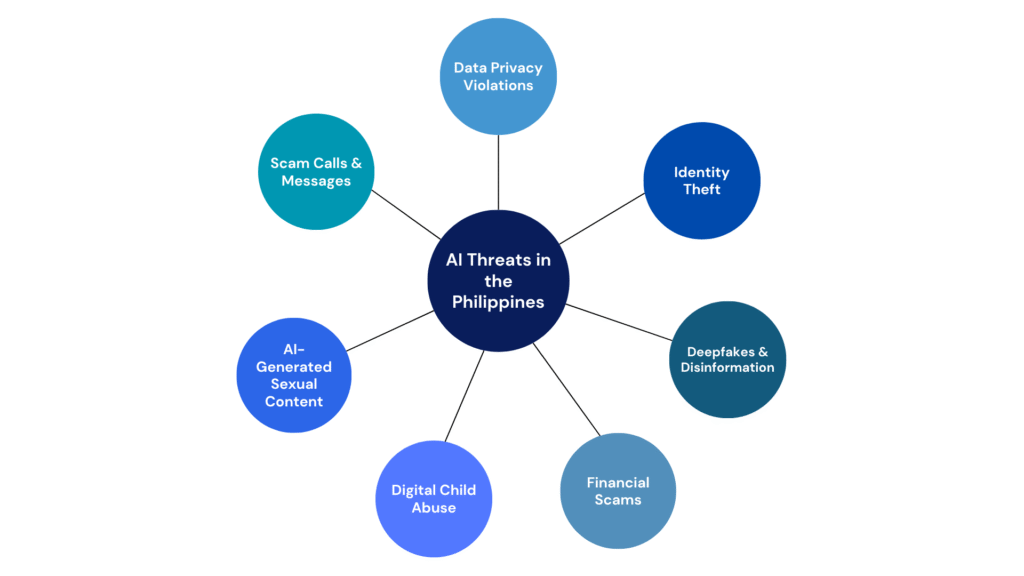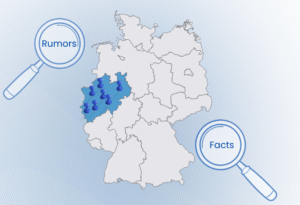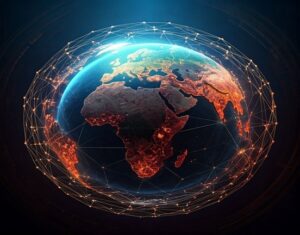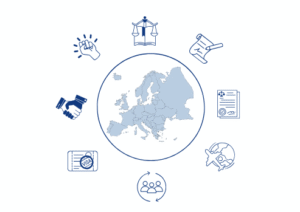Artificial Intelligence: Threat to the Philippines
By Sandra Chin
One of the greatest inventions and biggest threats to social media is the rise of artificial intelligence (AI). AI has helped connect people, businesses, schools, and organizations around the world. It has also created opportunities to expand networks and strengthen global connections. However, despite these capabilities, AI poses serious concerns.
In the Philippines, where social media and digital wallets are part of everyday life, AI is now being used not just to connect people, but to deceive them. AI presents new risks, including scams and disinformation which people are now starting to experience firsthand.
What Are Artificial Intelligence (AI) Threats
The internet can be used in many ways, but one of its negative effects is the rise of AI scams, which trick people into believing something that isn’t real. These scams use advanced tools like deepfake videos, which are AI-generated videos that manipulate a person’s appearance or voice to make it look like they said or did something they never actually did as well as AI-generated images to create sexual content and fake spam emails/SMS to scam. With these tools, scammers can easily create things that look and sound real, making it harder for people to tell what’s fake and what’s not.

Identity Theft
In early 2024, the Philippine News Agency reported that the PNP Anti-Cybercrime Group had been dealing with a growing number of online identity theft cases. From November 2023 to February 2024, they recorded 178 incidents where social media accounts were taken over. Nearly half of these cases happened in February alone. This scam usually starts when someone gains access to a person’s account without permission. The scammer then uses it to message the victim’s friends or family, often pretending to need money urgently.
Telecommunications Scams
As online threats continue to evolve, scammers are also shifting their methods. In a 2025 report by ABS-CBN News, in coordination with the Cybercrime Investigation and Coordinating Center (CICC), the public was warned about the rise in phone scams. While scam text messages have decreased compared to the previous year, scam calls have sharply increased. From January to March 2025 alone, scam calls rose by over 200%, showing a clear move toward more direct and personal tactics such as voice-based deception which is the use of AI-generetad or manipulated audio to mimic a person’s voice and trick others into believing they are speaking to the real person.
Digital Child Abuse and Exploitation
Beyond financial scams and identity theft, the misuse of AI has become even more alarming in areas involving child safety and exploitation. According to a recent article by the Philippine News Agency, the Council for the Welfare of Children (CWC) raised serious concerns about the growing use of AI in child abuse cases. In a related report, the International Justice Mission (IJM) revealed that over half a million Filipino children had been trafficked online through livestreams as of 2022. Disturbingly, some of their photos have reportedly been used to create AI-generated sexual content, raising urgent ethical, legal, and human rights issues.
Legal Framework in the Philippines
With the growing risks brought by AI, it’s important to look at the current legal framework in the Philippines. While some AI-related bills are still waiting to be passed, others have already been approved to help create safer and stronger laws. House Bill 7913 focuses on creating a national AI strategy for the responsible use and development of AI in the country. House Bill 7983 promotes AI education and research to support innovation and raise public awareness. House Bill 7396 aims to help industries use AI to improve public services and boost the economy. Meanwhile, House Bill 9448 pushes for stricter rules and ethical standards to protect the public from the misuse of AI. Along with these proposed laws, the Philippines also has existing laws that deal with digital threats, such as the following:
- Cybercrime Prevention Act of 2012 (Republic Act No. 10175) – The Cybercrime Prevention Act of 2012, also known as Republic Act No. 10175, is a law that deals with crimes involving the use of technology. It defines and punishes offenses like online fraud, identity theft, and other illegal activities done through computers or the internet.
- Data Privacy Act of 2012 (Republic Act No. 10173) – The Data Privacy Act of 2012, or Republic Act No. 10173, is a law that protects personal information handled by both public and private sectors. It sets rules on how data should be collected, used, stored, and shared to ensure transparency and security. The law also imposes penalties for unauthorized access, use, or sharing of personal data.
- Anti-Photo and Video Voyeurism Act of 2009 (Republic Act No. 9995) – The Anti-Photo and Video Voyeurism Act of 2009 or Republic Act No. 9995, makes it illegal to take photos or videos of someone’s private parts or sexual acts without their consent. It also bans sharing, selling, or posting those images or videos. Even if the person agreed to be recorded, the law still requires written consent before using or spreading the content.
- Expanded Anti-Trafficking in Persons Act of 2022 (Republic Act No. 11862) – The Expanded Anti-Trafficking in Persons Act of 2022, or Republic Act No. 11862, is a law that strengthens the fight against human trafficking in the Philippines. It updates the old law to cover modern trafficking methods, especially those using technology and involving crimes across countries. The law also includes stronger protection for children and punishes online sexual abuse and exploitation.
Legal and Policy Recommendations
Given the rise of AI‑driven scams in the Philippines, updating the country’s legal framework is critical. The Cybercrime Prevention Act (RA 10175), while foundational, does not explicitly cover modern threats like AI-generated voices, deepfakes, or automated scam bots. Lawmakers, including the Department of Information and Communications Technology (DICT), are seeking amendments to include stricter penalties for the misuse of AI in generating false identities and social media accounts used for scams.
To facilitate more effective enforcement, coordination among agencies should be improved through a one-stop reporting and investigation center. Senator Mark Villar’s proposed Philippine Scam Prevention Center (PSPC) under the CICC is designed to bring government divisions together with telecommunications and fintech companies into a unified task force. This would reduce fragmentation and accelerate response times.
In connection to that, platform accountability must be strengthened. The DICT–CICC has urged platforms to deploy AI-led detection systems, flag repeat offenders, and comply with authority requests under the Internet Transactions Act (RA 11967). Additionally, under BSP and NPC rules, financial services and e-commerce providers must report scam attempts and implement transaction-screening based on scam patterns.
Moreover, public education remains essential. The CICC’s 2023 Asia Scam Report found that Filipinos often fall victim because they “respond too quickly” to scammers (24.8%) or are misled by incentives (20.5%). Thus, educational offices should include digital literacy in curricula and community training, particularly in barangays and rural areas, to teach people how to spot scam red flags.
Finally, victim support should be comprehensive and empathetic. The Philippine news reports emphasize severe emotional and financial damage, such as online “love scam” losses up to ₱260,000 (4,602 USD or 3,937 EUR) and mental health tolls. The government, via the Department of Social Welfare and Development (DSWD) and Public Attorneys Office (PAO), should offer hotline services, legal aid, counselling, and pathways to financial restitution.
Conclusion
Acknowledging the scale of the threat, it is clear that AI-enhanced scams posing as romance, investment, or sympathy schemes are undermining trust in digital infrastructure. They cut across all segments from students to senior citizens, from micro-entrepreneurs to families in the provinces. This growing problem needs immediate action. Reinforcing RA 10175 with new AI-specific provisions, establishing the PSPC, enforcing platform responsibility, educating the public, and supporting victims must proceed in parallel. Only an integrated, multi-stakeholder response will keep pace with scam operators. Delaying action risks deeper harm: onward financial loss, more mental stress, and greater erosion of trust in banks, government agencies, digital platforms and in each other. But if decisive steps are taken, the Philippines can safeguard its digital transformation and protect its most vulnerable citizens.






